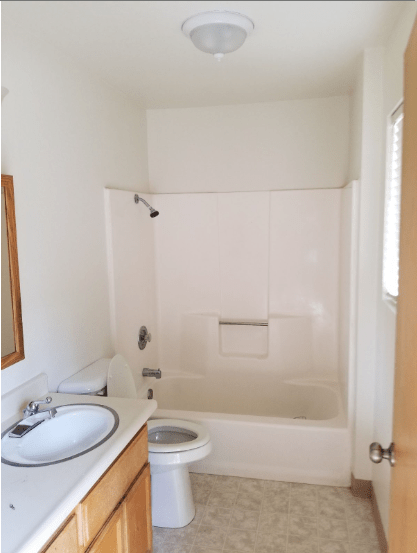Best Paint for Bathroom
Call: (209) 257-3501


Interior Paint

Exterior Paint
When choosing the best paint for bathroom, there are a few key factors to consider. First and foremost, you want a paint formulated explicitly for high-humidity environments, as bathrooms tend to be prone to moisture. Look for paints labeled as bathroom or kitchen and bath paints, as these will typically have additives that help resist mold and mildew growth.
Another important consideration is the finish of the paint. In bathrooms, where water splashes are inevitable, opting for a semi-gloss or satin finish is wise. These finishes not only provide better durability and moisture resistance but also make cleaning more accessible by allowing you to wipe off any splashes or stains with minimal effort.
Lastly, remember color! While white may be the classic bathroom choice due to its clean and bright appearance, explore other options that add personality and charm to your space. Soft blues or greens can create a soothing atmosphere, while warm neutrals like beige or taupe bring warmth and sophistication.
With these factors in mind, you can confidently select the best paint for your bathroom with style and functionality. Remember to prioritize moisture resistance with specially formulated bathroom paints, choose an appropriate finish for easy cleaning, and select colors that reflect your taste and create an inviting environment. Happy painting!
Choosing the Right Paint for Your Bathroom
When choosing the right paint for your bathroom, it’s essential to consider both style and practicality. While you may be tempted to go for a bold color that adds personality to the space, it’s crucial to choose a paint that can withstand the high humidity levels often found in bathrooms. Look for paints designed explicitly for moisture-prone areas like bathrooms, as these will have added features such as mold and mildew resistance.
In addition to durability, consider the overall aesthetic you want to achieve in your bathroom. Depending on the size and natural lighting of the space, you may opt for lighter colors to create an illusion of more open and airy surroundings. Alternatively, suppose you want a cozy and intimate feel. In that case, deeper shades like navy or charcoal can add a touch of drama. Consider also how these colors will complement existing fixtures and accessories in your bathroom.
Lastly, remember the finish! A high-gloss or semi-gloss paint is recommended for bathroom walls due to its ability to repel moisture and make cleaning easier. However, suppose glossier surfaces are different from your preference or fit with your desired style. In that case, there are also options such as satin or eggshell finishes that can still offer some water resistance.
Importance of Using Bathroom-Specific Paints
Bathrooms are unique spaces in our homes that require special attention when choosing the right paint. Using bathroom-specific paints is crucial for maintaining the longevity and overall condition of this high-moisture area. Regular paints may not be able to withstand the humidity and moisture that accumulate in bathrooms, leading to peeling, blistering, and mold growth.
Bathroom-specific paints are formulated with special additives that make them resistant to moisture, mold, mildew, and bacteria. These paints also have a higher gloss or sheen finish, which helps repel water and make cleaning easier. Additionally, they often contain antimicrobial properties that prevent the growth of bacteria on surfaces. By using bathroom-specific paints, you can ensure that your walls remain durable and free from any harmful substances.
Factors to Consider When Choosing Paint for Bathroom
When choosing a paint for your bathroom, there are several important factors to consider. The first factor is moisture resistance. Bathrooms typically have high humidity levels, which can cause regular paint to peel and fade over time. It is crucial to choose a paint specifically designed to resist moisture and withstand the humid conditions of a bathroom.
Another factor to keep in mind is mold and mildew resistance. Bathrooms are prone to the growth of mold and mildew due to the constant exposure to water. Therefore, it is essential to select a paint that has antimicrobial properties or contains additives that inhibit the growth of mold and mildew.
Furthermore, consider durability when selecting bathroom paints. Bathrooms experience heavy use with frequent cleaning, so you need paint that can withstand scrubbing without losing color or finish. Look for paints with high washability ratings for easier maintenance.
Finally, remember aesthetic considerations. While functionality should be prioritized in bathrooms, you still want your space to look visually appealing. Choose colors and finishes that complement the overall design scheme of your bathroom while also meeting the functional needs mentioned above.
Best Paints for High Moisture Environments
When it comes to choosing the right paint for high-moisture environments like bathrooms, it’s crucial to opt for products that are specifically designed for durability and resistance to mold and mildew. One excellent option is a semi-gloss or satin finish paint, which not only gives your bathroom walls a sleek look but also provides an extra layer of protection against moisture damage. These paints are easy to clean and perfect for spaces prone to splashes and humidity.
Another essential factor to consider is the formulation of the paint. Look for brands that offer both water-based and oil-based options. Water-based paints are known for their quick dry time, low odor, and ease of application. On the other hand, oil-based paints tend to be more durable and resistant to stains, making them an ideal choice if your bathroom sees heavy use or has high humidity levels.
Lastly, remember color! While white or neutral shades may be popular choices due to their timeless appeal and ability to create a sense of spaciousness in small bathrooms, don’t be afraid to experiment with bolder hues as well. Blues and greens can evoke a calming spa-like atmosphere while adding personality and visual interest. Ultimately, finding the best bathroom paint requires considering factors like finish type, formulation, and color choice – ensuring both style and functionality in your sanctuary within the home.
Best Paint Colors for Bathrooms
When choosing the best paint colors for bathrooms, it’s essential to consider style and functionality. While white is a classic choice that can create a clean and minimalist look, dark colors like navy blue or charcoal gray can add drama and sophistication to the space.
Additionally, pale shades of blue or green can create a serene and spa-like atmosphere, perfect for unwinding after a long day.
Another trend in bathroom paint colors is bold and vibrant hues. Bright shades of yellow or orange can inject energy into smaller bathrooms and make them appear larger. On the other hand, soft pastel tones such as blush pink or mint green are perfect for creating a feminine and charming ambiance.
Ultimately, selecting the best paint color for your bathroom depends on your preferences and the overall design aesthetic you want to achieve. Consider factors such as lighting, size of the space, and existing fixtures when making your decision. Be bold and experiment with different shades once you find the one that perfectly suits your style and creates an inviting environment in your bathroom.
How to Properly Apply Bathroom Paint
When painting your bathroom, choosing the right type of paint is crucial. Opt for a high-quality satin or semi-gloss finish that can withstand moisture and condensation. Before applying the paint, prepare the walls by removing any loose or peeling old paint and sanding down any rough spots. Use a damp cloth to wipe away dust and dirt, ensuring a clean surface.
Next, make sure you have all the necessary tools at hand – a good quality brush, several rollers with different nap lengths for other areas, painter’s tape to protect trim and fixtures, drop cloths to cover the floor, and a tray for pouring paint into. Start by cutting in along the edges of the bathroom with a brush before using a roller for larger surfaces. Apply even coats of paint in one direction while maintaining a wet edge to avoid visible brush or roller marks.
One often overlooked aspect of bathroom painting is ventilation. Open windows and doors if possible, or use an exhaust fan during the painting process to help dissipate fumes and prevent them from lingering in your home. It’s also essential to allow sufficient drying time between coats and after completing the final coat before using your shower or bath again.
Following these steps will ensure that your bathroom has an even and professional-looking paint job that not only adds visual appeal but also protects against moisture damage over time. Happy painting!
Conclusion: Choose a Durable, Moisture-Resistant Paint
In conclusion, choosing durable and moisture-resistant bathroom paint is crucial for maintaining the overall aesthetics and longevity of your bathroom walls. While it may be tempting to opt for a cheaper option, investing in high-quality paint will save you money and headaches in the long run. Not only will a durable paint withstand frequent exposure to steam and water splashes, but it will also resist mold and mildew growth.
Furthermore, moisture-resistant paints are specifically formulated to prevent peeling, cracking, or blistering due to humidity levels standard in bathrooms. This means you won’t have to worry about constantly repainting your bathroom walls or dealing with unsightly damage caused by moisture. Additionally, these paints often have added benefits, such as accessible cleaning properties, which reduce maintenance efforts required to keep your bathroom spotless.
Remember that the bathroom is one of the most frequently used spaces in any home, and its walls endure constant exposure to humidity. By choosing durable and moisture-resistant paint, you can ensure that your bathroom not only looks pristine but also remains protected against potential damage from water-related issues. So don’t underestimate the importance of this decision – invest wisely in high-quality paint that can withstand even the most challenging conditions without compromising on style or durability.
Don’t forget to check out our other website!

